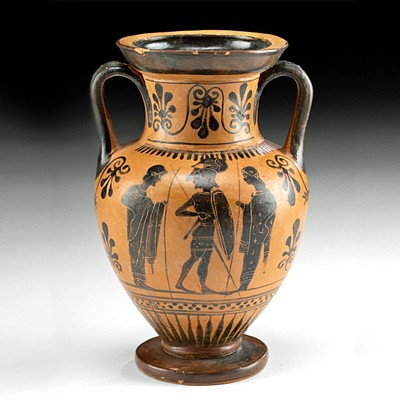Fine 16th C. Hawaiian Stone Poi Pounder
Lot 225
About Seller
Artemis Gallery
686 S Taylor Ave, Ste 106
Louisville, CO 80027
United States
Selling antiquities, ancient and ethnographic art online since 1993, Artemis Gallery specializes in Classical Antiquities (Egyptian, Greek, Roman, Near Eastern), Asian, Pre-Columbian, African / Tribal / Oceanographic art. Our extensive inventory includes pottery, stone, metal, wood, glass and textil...Read more
Categories
Estimate:
$2,400 - $3,600
Absentee vs Live bid
Two ways to bid:
- Leave a max absentee bid and the platform will bid on your behalf up to your maximum bid during the live auction.
- Bid live during the auction and your bids will be submitted real-time to the auctioneer.
Bid Increments
| Price | Bid Increment |
|---|---|
| $0 | $25 |
| $300 | $50 |
| $1,000 | $100 |
| $2,000 | $250 |
| $5,000 | $500 |
| $10,000 | $1,000 |
| $20,000 | $2,500 |
| $50,000 | $5,000 |
| $100,000 | $10,000 |
| $200,000 | $20,000 |
About Auction
By Artemis Gallery
Mar 9, 2023
Set Reminder
2023-03-09 10:00:00
2023-03-09 10:00:00
America/New_York
Bidsquare
Bidsquare : Exceptional Ancient, Ethnographic, & Fine Art
https://www.bidsquare.com/auctions/artemis-gallery/exceptional-ancient-ethnographic-fine-art-12354
Artemis Gallery info@artemisgallery.com
Artemis Gallery info@artemisgallery.com
- Lot Description
**First Time At Auction**
North Pacific, Hawaiian Islands, Maui, Lahaina, Pre-Contact Period, ca. 16th to 18th century CE. A finely preserved poi pounder of a bell-shaped form carved from brown-hued stone. The hefty tool is comprised of a rounded pounding face, a broad body with a carinated lower edge, a gently tapered handle, and a hemispherical knob tip that facilitated the movement and handling of the tool. The handle and top of the knob exhibit a pleasing smoothness that suggests this tool was used to prepare countless dishes of pulverized taro root known as poi. Size: 4.4" W x 6.75" H (11.2 cm x 17.1 cm)
Poi pounders, alongside adzes, were the most important stone tools in Polynesia and the Hawaiian Islands (Europeans introduced steel weapons). They are used for pounding cooked taro root into poi, a staple of the islander diet. Taro root was steamed in an earthen oven, peeled using shells, and placed onto a slab of wood to be pounded. The pounded results were blended with water into a highly nutritious paste. Traditional calabash bowls were used as containers to hold poi mixtures, and traveling royalty were accompanied by their own poi maker, with his or her own poi-making implements like this one.
IMPORTANT NOTE: This item falls under the Safeguard Tribal Objects of Patrimony Act and is not eligible for international shipping. Native American, Alaska Native, & Native Hawaiian objects are only eligible to ship within the United States.
Provenance: private Hawaii collection, acquired 2000 to 2010
All items legal to buy/sell under U.S. Statute covering cultural patrimony Code 2600, CHAPTER 14, and are guaranteed to be as described or your money back.
A Certificate of Authenticity will accompany all winning bids.
We ship worldwide and handle all shipping in-house for your convenience.
#177504Minor nicks, pitting, and abrasions, otherwise intact and excellent. Great surface smoothness in most areas indicative of use, and nice stone color. Previous inventory number handwritten in black pigment atop petite area of white paint beneath pounding face.Condition
- Shipping Info
-
All shipping is handled in-house for your convenience. Your invoice from Artemis Gallery will include shipping calculation instructions. If in doubt, please inquire BEFORE bidding for estimated shipping costs for individual items.
-
- Buyer's Premium



 EUR
EUR CAD
CAD AUD
AUD GBP
GBP MXN
MXN HKD
HKD CNY
CNY MYR
MYR SEK
SEK SGD
SGD CHF
CHF THB
THB














